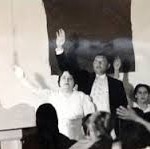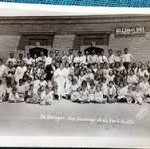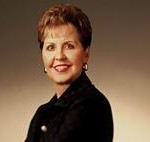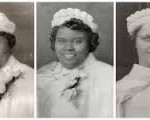 Another installment of my look at Pentecostal women looks at a Church of God missionary named Maria W. Atkinson, who, like several other better known Pentecostal women, was a widowed and divorced woman during the 1920s and 30s when such things were unheard of. It makes you wonder how certain women were able to find that elusive “wiggle” room to get out of marriages that stifled their careers?
Another installment of my look at Pentecostal women looks at a Church of God missionary named Maria W. Atkinson, who, like several other better known Pentecostal women, was a widowed and divorced woman during the 1920s and 30s when such things were unheard of. It makes you wonder how certain women were able to find that elusive “wiggle” room to get out of marriages that stifled their careers?
Maria Atkinson was born into a Catholic upper-middle class family in Sonora, Mexico, in 1877. The Atkinson wealth came from silver mining. Atkinson seems to have experienced ecstatic experiences early on in her life, as the semi-hagiographic biography of her and her denomination note. At the age of 14, Atkinson experienced a vision of Jesus at Mass. She stayed in that ecstatic state for several hours. Church of God author Charles Conn notes that Atkinson exchanged the “ mariolatry of Romanism for the simple faith of evangelical Protestants.” Conn failed to note that the ecstatic like state that lasts for hours is a time honored trope of many Catholic mystics.
As the Mexican Revolution displaced thousands, Atkinson immigrated north of the border and settled in Douglas, Arizona, where she married Mark Atkinson. Maria’s story of how she became Pentecostal is typical of hundreds, if not thousands of people who have come to the faith by a healing experience. In 1924 she was diagnosed with cancer, her washwoman, Maria Ybarra, talked to her about the possibility of faith healing and Atkinson began attending a local Assemblies of God church in hopes of receiving healing. She reported being healed and thereafter joined the Assemblies of God as a missionary. Mark Atkinson, who may have never converted, refused to follow his wife into missions so she left Arizona and went back to Mexico without him. In 1926, she returned to Mexico as a missionary. She affiliated with the Church of God and established Pentecostal communities in Nogales, Santa Ana, Hermosillo, and Ciudad, Obregon.
Atkinson tended to focus on preparing other missionaries and on training her charges on the proper way to conduct themselves and make themselves respectable. No doubt, her wealthy upbringing instilled in her a sense of propriety she apparently felt was missing among her followers. In addition to this socialization, Atkinson used her teacher training to teach people to read. Atkinson would become a “pioneer” missionary in the Church of God. There is little in the written records or in the scant academic literature as to why a divorced women would be afforded such honor and praise, but that is the curious thing about women in Pentecostal churches.
 Then as now they are necessary since today they comprise at least 50% of the attendees, but they are expected to yield to a series of proscriptions that fit a particular biblical worldview that just happens to promote the idea of female submission as the ideal. Divorce is not the ideal and at one time it was prohibited and divorced people who re-married were viewed as adulterers, but this view, while still adhered to in the abstract more than the reality is something that Pentecostal churches have never viewed as automatically disqualifying someone from ministry. The trump card that Atkinson seemed to play, as did McPherson, as have countless others is the selective biblical admonition not to be unequally yolked. This card, once played, allowed women like Atkinson to not only divorce their husbands, but leave them behind to continue on with their careers–an impressive feat indeed.
Then as now they are necessary since today they comprise at least 50% of the attendees, but they are expected to yield to a series of proscriptions that fit a particular biblical worldview that just happens to promote the idea of female submission as the ideal. Divorce is not the ideal and at one time it was prohibited and divorced people who re-married were viewed as adulterers, but this view, while still adhered to in the abstract more than the reality is something that Pentecostal churches have never viewed as automatically disqualifying someone from ministry. The trump card that Atkinson seemed to play, as did McPherson, as have countless others is the selective biblical admonition not to be unequally yolked. This card, once played, allowed women like Atkinson to not only divorce their husbands, but leave them behind to continue on with their careers–an impressive feat indeed.
It is difficult to speculate on why Atkinson and later, the more (in)famous Aimee McPherson would risk being viewed as social outcasts for leaving their husbands? In an era before no-fault divorce, before any reform of laws covering divorce, they decided that it was worth the risk. What may be safe to say is that because these two women chose to pursue ministry, it became acceptable to leave behind husbands that were not supportive of their “calling.” In effect, what Pentecostals now and then might have allowed for is for Atkinson and McPherson to get out of their marriages because they were both “unequally yoked” with men who were unconverted or simply uninterested.
The bigger scandal than divorce it seems would be to have stayed married to unrepentant men who were hostile, apathetic, or in Mark Atkinson’s case, simply did not believe that his wife had a role to play outside the role of home-maker and mother. In Maria’s case, stuck between the twin proscriptions of gendered living: marriage to men and marriage to the church–she chose the one that seemed to offer her most opportunities for self-fulfillment and career growth.












